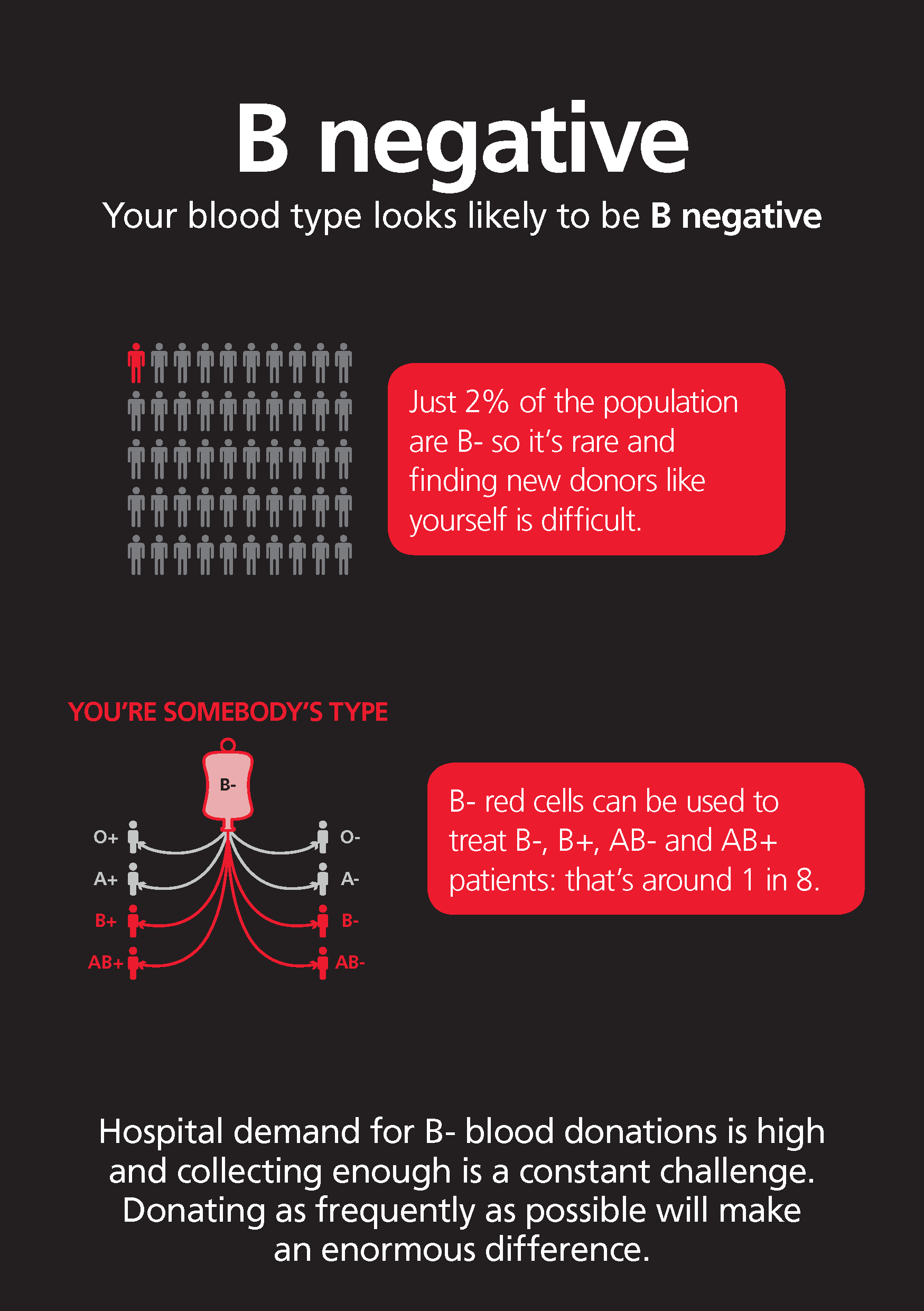
Rule 1: The number 1 or ‘ (single prime) after the R or r, respectively, tells you to capitalize the first of the two remaining openings, the C/c position, and results in a “ Ce” combination.įor example, for R1, the first position, C/c, is capitalized and the second, E/e, is not, like so:

B negative blood type origin how to#
Good news! The number, letter, or symbol after the “R” or “r” guides you on how to fill in the boxes above. You’ve got two positions left to fill (the C/c and E/e positions): Look at the image below: You’ve already completed the D/d position by looking at the haplotype. You just have to figure out the combination of C/c and E/e that makes up the rest of the list of three antigens in the haplotype. So, the main part of your work is already done! You know that any haplotype that starts with “R” has a “D,” and any that starts with an “r” does not have D (so you write that as “d”). Conversely, it’s easy to see that all of the haplotype that start with a small “r” lack D (remember, all of these have a “little d” at the start of the list of three antigens in the haplotype, but there is no “d,” only the absence of “D”). First, look closely at the table above and notice that all the D-positive combinations (haplotypes) in the left column have the a capital “R” as the letter in the shorthand (and start off with a capital “D” in the list of three antigens). Looks Complicated! How Do I Memorize This?ĭon’t worry I’m not going to stop there! There are ways to break this down to make it more manageable. Those names are blood bank gospel, and you must memorize them if you are going to be involved in blood banking! Plus, virtually anyone writing test questions covering the Rh system will expect you to know them cold! Here is the modified Wiener terminology for the eight Rh haplotypes: Wiener gave shorthand names to the eight possible haplotypes resulting from the possible combinations of the alleles of those three genes mentioned above. Most of what he proposed has been discredited, but he did develop something that we still use today. Alexander Wiener, was developing his own theory and shorthand terminology scheme. Meanwhile, another famous blood banker, Dr. We now know that this theory was wrong (more on this in a minute), but the names for the five main antigens (D, C, c, E, and e) stuck around. Each child received a group of Rh genes from each parent (a so-called “ haplotype“), and the combination of alleles inherited from both parents resulted in the child’s final Rh phenotype. Years ago, based on the theories of Fisher and Race in England, blood bankers believed that the five main antigens were inherited as a combination of alleles from three different genes: One D gene, one gene for C or c (called “ C/c” which coded for either C or c, not both), and one gene for E or e (called “ E/e” and likewise coding for either E or e). Little d is a silly way to say or write it, because there is no little d antigen little d is merely a slang term to indicate that there is no D. Commonly, blood bankers will use the term “d” (“little d”) to indicate the lack of the D antigen (in other words, we will describe someone who is Rh negative either as “D-negative” or when writing it, as “d”). The presence or absence of D defines a person as “Rh positive” or “Rh negative,” an extremely important distinction that establishes a person’s basic blood type (in conjunction with their ABO type). Those five (which we call “ D, C, c, E, and e”) account for the vast majority of clinical and laboratory issues in this blood group, and for most of the confusion that people learning the terminology experience! The Deal with D and dīefore we get rolling, you must understand this: The D antigen is the main Rh antigen. As of May 2016, we know of at least fifty Rh antigens according to the International Society for Blood Transfusion, but we spend most of our time worrying about only five of them.

The Rh blood group system is a complex set of red blood cell surface proteins that most likely function to maintain the integrity of the cell membrane. “But, Joe,” you cry, “surely you can make this easy for us!” My friends, the answer is “no, I’m just not THAT good ( and don’t call me “Shirley”)! But, I can make it easi er!” This post is designed to help you get started on the right track, and is the first of two on this topic. We say things like, “well, the most likely genotype is R 1R 1, obviously” when it just isn’t obvious at all when you are trying to figure things out! Further, the genetics of this system have been variously understood and explained over the years, and it is very easy to get lost in the jungle of phrases and haplotypes and buzzwords! Beginners trying to understand the system are often really confused by all the terminology that blood bankers use to describe the five main Rh antigens. The Rh blood group system is spectacularly complex, while at the same time enormously important.


 0 kommentar(er)
0 kommentar(er)
